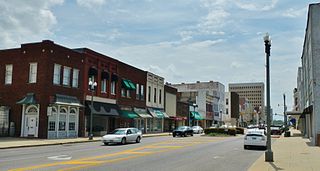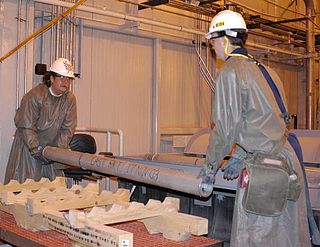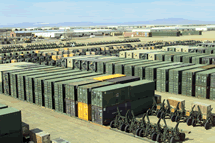
Anniston is the county seat of Calhoun County in Alabama and is one of two urban centers/principal cities of and included in the Anniston-Oxford Metropolitan Statistical Area. As of the 2010 census, the population of the city was 23,106. According to 2019 Census estimates, the city had a population of 21,287.
Tooele Army Depot (TEAD) is a United States Army Joint Munitions Command post in Tooele County, Utah. It serves as a storage site for war reserve and training ammunition. The depot stores, issues, receives, renovates, modifies, maintains and demilitarizes conventional munitions. The depot also serves as the National Inventory Control Point for ammunition peculiar equipment, developing, fabricating, modifying, storing and distributing such equipment to all services and other customers worldwide. TEAD provides base support to Deseret Chemical Depot.
General Dynamics Land Systems (GDLS) is a manufacturer of military vehicles such as tanks and lighter armored fighting vehicles.

The Tooele Chemical Agent Disposal Facility or TOCDF, is a U.S. Army facility located at Deseret Chemical Depot in Tooele County, Utah that was used for dismantling chemical weapons.
Blue Grass Army Depot (BGAD) is a U.S. Army Joint Munitions Command storage facility for conventional munitions and chemical weapons. The facility is located in east central Kentucky, southeast of the cities of Lexington and Richmond, Kentucky. The 14,494-acre (58.66 km2) site, composed mainly of open fields and wooded areas, is used for munitions storage, repair of general supplies, and the disposal of munitions. The installation is used for the storage of conventional explosive munitions as well as assembled chemical weapons. The depot primarily is involved in industrial and related activities associated with the storage and maintenance of conventional and chemical munitions.
Anniston Chemical Activity was a U.S. Army chemical weapon storage site located in Alabama. The Army had stored approximately seven percent of the nation’s original chemical weapons stockpile at the Anniston Army Depot since the early 1960s. In August 2003, the Army began disposing of these weapons at the Anniston Chemical Agent Disposal Facility. Destruction of the base's stockpile of VX was begun on July 23, 2006. By December 2008, all of the VX on site had been destroyed. Destruction of mustard-filled munitions began on July 2, 2009 after several months of retooling. By July 2010, it had destroyed by incineration 75% of the depot's total stockpile including all 437 tons of GB (sarin) and all VX nerve agent on site. On September 22, 2011, the last mustard gas shells were burned, completing chemical weapons disposal at the facility. The facilities were scheduled for dismantlement by about 2013 and some of the weapon-handling equipment was planned for transfer to the depots at Kentucky and Colorado. Local government emergency departments are expecting to lose millions in annual funding from the federal government related to the presence of the chemical depot and as many as 1000 jobs will be cut on the base.

Letterkenny Army Depot, the Center of Industrial and Technical Excellence (CITE) for Air Defense and Tactical Missile Systems, was established in early 1942. Its leadership began recruiting civilian personnel in July 1942.

The United States Army Tank-automotive and Armaments Command (TACOM), and its subordinate Life Cycle Management Command (LCMC), headquartered at the Detroit Arsenal in Warren, Michigan, is part of the United States Army Materiel Command (AMC).

The Stratford Army Engine Plant (SAEP) was a U.S. Army Tank-Automotive and Armaments Command installation and manufacturing facility located in Stratford, Connecticut, where it was sited along the Housatonic River and Main Street, opposite Sikorsky Memorial Airport.
The Anniston–Oxford metropolitan statistical area is the most populated metropolitan area in Northeast Alabama next to Huntsville. At the 2000 census, it had a population of 112,249. The MSA is anchored by significant jobs at Jacksonville State University, the Northeast Alabama Regional Medical Center, Stringfellow Hospital, the Anniston Army Depot, and the Department of Homeland Security at McClellan. McClellan has transitioned from being a closed military base, to becoming the home of hundreds of residents, new retail growth such as a Lowe's Home Improvement Store, and now more than 3,000 jobs spread out over more than 20 employers. Anniston remains strong in health care, legal, financial services and manufacturing. Oxford, with Interstate 20 running right through it, has developed a number of retail and restaurant establishments including the Oxford Exchange which is anchored by Target.
The Anniston Defense Munitions Center (ADMC) located at Anniston Army Depot in Bynum, Alabama, is a multi-functional ammunition facility under the US Army Joint Munitions Command.. The primary mission is receipt, storage, surveillance and shipment of missiles and conventional ammunition. The ADMC is the site of the Department of Army’s only Missile Recycling Center and is one of the Army’s premium ammunition storage sites because it is capable of storing some of the Army’s largest munitions.
Pemaco is a former chemical mixing company and facility located on the Los Angeles River in Maywood, a small city in southeastern Los Angeles County, California.
Throughout history, chemical weapons have been used as strategic weaponry to devastate the enemy in times of war. After the mass destruction created by WWI and WWII, chemical weapons have been considered to be inhumane by most nations, and governments and organizations have undertaken to locate and destroy existing chemical weapons. However, not all nations have been willing to cooperate with disclosing or demilitarizing their inventory of chemical weapons. Since the start of the worldwide efforts to destroy all existing chemical weapons, some nations and terrorist organizations have used and threatened the use of chemical weapons to leverage their position in conflict. A notable example includes the use of such weapons by the US government that sprayed more than 20 million gallons of various herbicides over Vietnam, Cambodia and Laos from 1961 to 1971. Agent Orange, which contained the deadly chemical dioxin, was the most commonly used herbicide. Other examples of the use of chemical weapons are Iraq’s Saddam Hussein on the Kurdish village Halabja in 1988 and their employment against civilian passengers of the Tokyo subway by Aum Shinrikyo in 1995. The efforts made by the United States and other chemical weapon destruction agencies intend to prevent such use, but this is a difficult and ongoing effort. Aside from the difficulties of cooperation and locating chemical weapons, the methods to destroy the weapons and to do this safely are also a challenge.

The Red River Army Depot (RRAD) is an 15,375-acre (62.22 km2) depot-level maintenance facility 18 miles (29 km) west of Texarkana, Texas, in Bowie County.

Sierra Army Depot (SIAD) is a United States Army post and military equipment storage facility located near the unincorporated community of Herlong, California. It was built in 1942 as one of several ammunition storage facilities located far enough inland to be safe from Japanese attack, yet close enough to western military posts and ports to facilitate shipment of supplies. The site also met the requirement that the depot be in a dry and isolated area.
The Alabama Regional Communications System (ARCS) is a radio/alert notification communications district with responsibility for providing user-based administration for operations and maintenance of the interoperable communications system that serves Calhoun County, Alabama and Talladega County, Alabama. The Motorola trunked radio system is licensed by the Federal Communications Commission (FCC) to operate on radio frequency spectrum in the 800 megahertz (MHz) public safety band.
Kauffman & Minteer Inc. (K&M) was an industrial transportation company that operated from 1960 to 1981 in Burlington County, New Jersey. After cleaning their trucks, they dumped the waste water into a nearby lagoon that was not properly lined. The lagoon flooded and the waste water containing chemicals, migrated over to wetlands, causing damage to vegetation and seeping into underground drinking water. The Environmental Protection Agency (EPA) got involved in 1989 and conducted a few remediation attempts but the extent of the damage is hard to determine as the different underground pathways of water are unpredictable. The site is currently an active superfund site that is closely monitored by the EPA.
The White Chemical Corporation Superfund site is 4.4 acres of contaminated industrial land in Newark, New Jersey, about a half mile away from Newark Airport. The Newark site operated from 1983 to July 1990, selling small amounts of chemicals. Some of the chemicals sold there were Trichloroethylene and 1-2-Dichloroethane. These chemicals were being improperly stored and leaked into the soil and groundwater. The EPA placed the property on the National Priorities List (NPL) in 1991, declaring it a Superfund site.

The M1074 Joint Assault Bridge System (JABS) is an American armored military engineering vehicle based on the Abrams M1A1 main battle tank. The M1074 was designed by Leonardo DRS to provide deployable bridge capability for units engaged in military operations.










